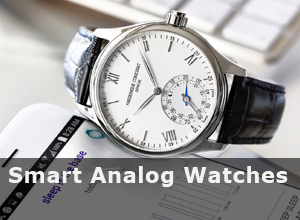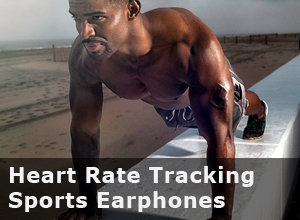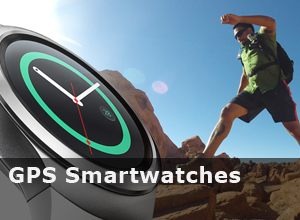The Garmin Vivoactive vs Fitbit Surge clash is near the top of the bill if you’re seeking a high-end fitness watch with a mixed bag of features!
Garmin wearables sit at the top of the league with their range of dedicated sports watches, such as the Forerunner 920XT, Epix and Fenix 3. These are arguably unmatched sporting wearables, and of course they pack Garmin GPS capability.
More recent Garmin Watches are incorporating lifestyle features like smart notifications and music control, which is bringing them more into the smartwatch zone rather than just hardcore fitness watches. The new Garmin Vivoactive is the best example of Garmin’s blend of smart and sports!
Fitbit need no introduction as they are the dominant force in wearable tech! The Fitbit Flex is the best-selling fitness tracker so far, and Fitbit are continuing that success with their new generation of wearables, mainly the Charge HR and the Surge. In my experience, even people who have no idea about wearables have heard of Fitbit! It’s a trendy brand which delivers quality products.
Anyway, down to business!
Garmin Vivoactive vs Fitbit Surge
Looks
Considering the Fitbit Surge is attempting to lean towards being more of a smartwatch than an all out fitness tracker, I think the design could be more SMARTwatch. Instead the Surge continues the minimalist aesthetics that Fitbit are known for. Somebody said to me that it looks like something out of the 70’s! You could almost say that the Surge looks so retro that it looks modern! The watch-face doesn’t protude above the strap and is thicker at one end which gives the Surge a distinctive look, it also has a surgical-grade stainless steel buckle.
The Garmin Vivoactive watch-face also hardly protrudes above the strap, it’s completely flat, very thin and VERY square. The buckle on the Vivoactive is also stainless-steel. But who cares about buckles, which one looks better?
Neither the Surge or Vivoactive are the best looking! If you prefer to keep your wearable tech minimal, and you’re into 70’s fashion (like Skinny Jeans) then you may prefer the Fitbit Surge. The Garmin Vivoactive looks better in my eyes. It looks more like a proper watch than the Surge.
Comfort
There’s little doubt that Fitbit make comfortable fitness trackers, as the Flex came out on top of yesterday’s generation. As far as smartwatches go, you’ll struggle to find one as comfortable as the Fitbit Surge, although it’s noticeably less comfy than smaller Fitbit wearables, such as the Flex or Charge.
The Garmin Vivoactive also doesn’t lack in lack in comfort. It’s slim, lightweight and considerably less bulky than other Garmin watches, but with its incredibly square watch-face, its comfort level isn’t on par with the surge, especially for sleeping and working out (which is probably what you’ll be doing most)

Although it’s more comfortable, the Fitbit Surge is a little bulkier than the Vivoactive, and also heavier. The Surge (small) weighs 49 grams, the Vivoactive weighs 38 grams.
The Surge has a more solid build, so if you get your shoelaces tangled up on the treadmill, the Surge would survive the fall better than the Vivoactive.
You can’t change the strap on the Fitbit Surge, as it’s an all-in-one unit. The Garmin Vivoactive straps are interchangeable.


Display
The Fitbit surge has a 0.82 x 0.96 inch, touchscreen, Monochrome, LCD display. The Surge screen stays on constantly and has a backlight which can be set to on, off or auto. The screen size is relatively small compared to other smartwatches, and it’s black and white so it’s not going to add any colour to your workouts.
The Garmin Vivoactive has a 1.13 x 0.80 inch, colour, LCD, touchscreen display. It is always on, and has a customizable backlight. The Vivoactive display is a bit larger than the surge, but it doesn’t cover as much of the watch face as I would like, the top quarter is taken up by the Garmin logo, and the bottom quarter by 2 capacitive buttons: Home and Back – which come in handy.
You can change watch faces on both wearables, but the amount available is a bit of a mismatch! The Fitbit Surge has 4 to choose from, whereas the Garmin Vivoactive has 111 at the time of writing this.
The Garmin Vivoactive screen looks better, but the touchscreen has a nanosecond more lag than the Fitbit Surge. Although the Surge screen doesn’t look the best, it has a nice feel when you’re swiping.
Sleep Tracking
The Fitbit Surge features automatic sleep tracking, it works well, and is impressive the way it knows when you drop off. One of the reasons that the Surge’s sleep tracker can accurately determine when you sleep is because it has access to the built-in HRM. It gives you analysis of sleep duration and periods of restlessness or wakefulness. Sleep tracking is not the Surge’s greatest feature, as analysis is pretty basic. There’s also has a vibration feature that can be used as a wake up alarm, but the alarm needs to be programmed through the app.
You can set the Fitbit Surge’s sleep tracker to either sensitve mode, or normal mode.
Here’s a few screen shots of the sleep tracking panel on the Fitbit app, the first one is on the PC, the second one is on my Android smartphone.
Fitbit Surge Sleep Tracking PC
Fitbit Surge Sleep Tracking Android
Garmin wearables needed to be programmed to track your sleep in the past, but Garmin have recently bought automatic sleep tracking to their sleep enabled devices. For me the Vivoactive’s automatic sleep tracking doesn’t work as well as the Surge. With the Vivoactive I prefer to enter sleep mode manually from the activity or watch screen by tapping the capacitive menu button on the bottom right of the display.
Like the Surge, sleep tracking is not the Vivoactive’s strongest feature! You get a basic graph showing you which parts of the night you were the most restless. It also has a vibration alarm to wake you up.
Below is two screenshots of the Garmin sleep tracking panel, Android on the left, PC on the right.
Heart Rate Monitor
The Fitbit Surge features a built-in optical heart rate sensor. It constantly monitors your BPM, this results in greater accuracy concerning calories burnt, and also helps the Surge understand your sleep patterns. Using a fitness tracker with constant HR monitoring enables you to see which things affect your heart rate, such as caffeine intake, emotional changes etc.
Having a constant heart rate monitor may help to provide you with more accurate activity data, but that depends on how accurate the HRM is! I’m yet to be convinced about the accuracy of optical wrist worn HRMs.
This obviously applies to Garmin, because at the time of writing this none of their watches have built-in optical heart rate sensors. Instead they use dedicated ECG accurate HRM chest straps which pair with their watches. These HRMs are certainly more accurate, and if you’re going to monitor your heart rate, you might as well do it accurately!
Fitness
The Fitbit Surge packs an abundance of fitness tracking features. It will log your heart rate, steps, distance travelled, calories burned, floors climbed, active minutes, it has an ambient light sensor, and watch mode. A recent update has brought automatic exercise detection to the Fitbit Surge.
The Garmin Vivoactive has all these features covered except the built-in HRM and ambient light sensor. It will log your steps, distance travelled, calories burned, elevation, active minutes, and has a watch mode.
![]()
Sports
The Fitbit Surge can track running, walking and hiking outdoors using its sensors and GPS, it will also track your indoor runs with a treadmill mode. The full list of exercise modes are: Run, walk, hike, bike, workout, weights, spinning, elliptical, yoga, pilates, stair climber, circuit training, bootcamp, kickboxing, tennis, golf, and martial arts. Only 7 of these sports modes can be set to the Surge as shortcuts at the same time.
Although the Surge has all these sports modes, they don’t really differ from each other much, basically they are just configured to display the appropriate stats; i.e calories, steps, distance, clock, and heart rate for tennis; calories, heart rate and clock for martial arts; calories, heart rate, pace, average pace, clock, and GPS for golf; etc.

As far as I can see, the only mode that gives you a real-time speed reading in Mph is the new Bike mode, and that isn’t exactly real-time as it only calculates your average speed. The Free Run mode (outdoors) doesn’t give you an Mph reading, instead it gives you a pace reading of how many minutes it would take to complete a mile.

Fibit Surge Bike Mode
When it comes to sports, Garmin wearables win! They have many dedicated wearables for different sports, such as swimming, golf, triathlon, and even flying! The Vivoactive brings some tidy sport tracking features.
The Vivoactive features indoor and outdoor sports tracking modes: Running (indoors and outdoors) , cycling (indoors and outdoors), walk (indoors and outdoors) golf and swimming. The running and bike modes track your speed, time, cadence and distance via GPS or accelerometer. Unlike the Fitbit Surge, the Vivoactive gives you a real-time Mph or Kph speed reading which is definitely a winning feature.

You can see in the image below, the real-time speed reading on the Garmin which is 2.4 Mph. (You can also see both GPS give different distance readings).

The sports mode data screens on the Vivoactive can be customized to display a variety of stats, unlike the Fitbit Surge which has pre-selected stats.

The Vivoactive is water-resistant up to 50 meters. Its dedicated swimming mode counts calories burned, lengths completed, stroke rate and pace. You can customize the data screens to display different stats, such as average stroke rate, interval stroke rate, and last length stroke rate, you can also customize pool length and more.
The Vivoactive doesn’t use its GPS in swim mode, and there’s no open water mode. If you want to track your open water swims with GPS you could always use the run mode, and count your steps as strokes. It doesn’t make much sense that GPS isn’t featured on swim mode, Garmin probably didn’t include it because they want you to buy one of their dedicated swimming devices.
The built-in app for golf uses GPS to measure distances and gives map data for 38,000 golf courses, calculates your exact shot distance, and yardage from the front, middle or back of the green.
As far as the accuracy of the accelerometers, I was impressed with both. I did some tests measuring my distance GPS vs accelerometers over a couple of miles and both the Surge and Vivoactive were only different by a few hundredths.
Smart Notifications & Features
The Fitbit Surge is lacking in the notification department, for me anyway, as I use email and social media more than texts and calls. It will only deliver incoming caller ID, text messages, and calendar alerts. It can be used to control your music playlist on your smartphone. It uses an AVRCP Bluetooth profile to control music, so your music app needs to be compatible with AVRCP.


The Garmin Vivoactive delivers incoming caller ID, text, email, social media, and calendar notifications. You can control the music playlist on your smartphone, and if you’ve got a VIRB compatible device, you can control that too. It also has a Find my Phone feature which is a little bonus.



The Garmin Vivoactive wins the notification battle..
GPS
The simple fact is that Garmin are the world’s leading consumer GPS device company! Strangely enough though, where I live in the South East of the UK the Fitbit surge finds a GPS signal faster than the Vivoactive! The Surge normally takes 5-10 seconds to find a signal, and the Vivoactive takes 10-15 seconds.
In terms of accuracy, they both give me pretty much the same distance readings on my routes, differing by only a few hundredths of a mile. Which one’s more accurate? It’s difficult to say, but probably the Garmin.
The Vivoactive supports GLONASS, but I’ve tried it a few times and it makes no difference, if anything it seemed to slow down the signal. GLONASS is a Russian satellite-based navigation system that works alongside GPS with 24 additional satellites. If I was in Russia it may have made a difference, but I aint. The Fitbit Surge doesn’t support GLONASS.
Battery Life
The Fitbit Surge will give you up to 5 days without GPS, and up to 5 hours with GPS. I was using the GPS for an hour or so everyday and getting about 3-4 days between charges. The Surge takes about 1.5 hours to charge. Update: Since this review the Surge has received an update that pretty much doubles the battery life in GPS mode – so up to 10 hours now..
The Garmin Vivoactive is supposed to give you up to 3 weeks in Activity Mode, and 10 hours in GPS mode. I also used the GPS for an hour or so everyday, and get about 6-7 days between charges. The Vivoactive takes closer to 2 hours to charge.
Water-Resistant
The Fitbit Surge has a water-resistant rating of 5 ATM – up to 50 Meters. Although it has a 5 ATM rating it should only be used for splashing around in shallow waters (no good for swimming!)
The Garmin Vivoactive has a water-resistant rating of 5 ATM – up to 50m, and can be used for swimming.
It’s difficult to make sense of these damn water-resistant ratings!!
App
The Fitbit app enables you to view your fitness and sleep history, map routes, compete with friends, earn badges and log calories manually or with a bar code scanner. It’s compatible with Android, iOS and Windows Phone. As of a few days ago, Fitbit devices now work with the popular fitness app, Strava. This is a bonus because Strava provides a more in-depth analysis, plus you can use satellite (terrain) view with the GPS which you couldn’t do with just the Fitbit app.
The Garmin Vivoactive works with Connect IQ. It’s a new platform driving Garmin’s new breed of wearables. It opens up APIs to developers so they can create new apps for whatever sports. This means that the Vivoactive and other Garmin devices are somewhat future proof and will continue to evolve.
I like the Garmin app, it gives you enough data about your activities, and very decent GPS analysis, including satellite (terrain) view. There is also a feature called LiveTrack. This enables you to invite your family and friends via email, Twitter or Facebook to track your progress in real-time when you are on the move, or taking part in a race. Those you invite will be able to see your stats, such as speed, elevation, distance etc. Garmin Connect is compatible with Android, iOS and Windows.
The Fitbit Surge OS firmware is more stable than the Garmin Vivoactive’s. The Surge only crashed on me once in a couple of weeks, resulting in me needing to shut it down and restart. The Vivoactive crashes more like once a day, it’s bearable because it recovers after about ten seconds, but still a bit annoying. It seems to be the third-party watch faces and widgets that you can download from Garmin Connect IQ that makes it crash, and also sometimes when it’s syncing.
Verdict
When it comes to regular fitness trackers, Fitbit have a proven track record with the best-selling Flex, but with the Surge they have entered a bigger pond with some big fish, i.e Garmin who simply make the best sporting wearables! Speaking of ponds, the Vivoactive is waterproof and the Surge isn’t!
The Vivoactive is more of a smartwatch than the Surge! It has a color display, and if you want emails, Twitter and Facebook messages on your wrist to read in a split second the Garmin is the choice! Also, you can customize far more of the features on the Vivoactive.
The Fitbit Surge does win in a few areas, like it doesn’t crash as much, it’s more comfortable, automatic sleep tracking works better, it now works with strava, has a built-in HRM, and to my surprise finds a GPS signal quicker.
I’ve spent a few weeks with both wearables, and I’m leaning towards the Garmin. They both cost pretty much the same, but I reckon the trendability of the Fitbit brand is pushing the Surge’s price up a tad. If the Fitbit Surge was handicapped with a lower price, it would give the Vivoactive a better fight.
Price
• Fitbit Surge
Around $249 USD
• Garmin Vivoactive
Around $249 USD
































I wish that either garmin would add the constant HR monitor (for daily activities) and allow the chest strap monitor for specific workout accuracy, or that fitbit would keep the continuous HR and add the ability to connect with an external (chest strap) monitor for the same reasons. This would give the best of both worlds. In chance of either of these happening soon?
Allen. I agree with your comment. Since this review Garmin have released a fitness watch with a wrist-based HRM, but it’s not constant. If you don’t mind taking your smartphone training with you, then syncing your Fitbit account with Strava or Endomondo and streaming your chest strap data is an option. Neither one is the perfect solution.
Came here looking for info on the Surge’s GPS capabilities. Thanks for the comparison, it’s useful to see some of the differences. However, the two quotes below seemed a bit strange;
“If you live in Russia, then GLONASS will benefit you, if not I don’t see too much point in switching it on. The Fitbit Surge doesn’t support GLONASS.”
GLONASS is worldwide – not just in Russia. It improves the accuracy and speed of position data acquisition when used alongside GPS.
“Unlike the Fitbit Surge, the Vivoactive gives you a real-time Mph or Kph speed reading which is definitely a winning feature.”
Strange comment… most runners -that I’ve met – use ‘pace’ (minutes per mile or km) rather than ‘speed’ to assess their runs.
Matt. I know devices that use GLONASS and GPS together are supposed to be able to find satellites up to 20 percent quicker than devices that rely just on GPS, but in my experience with the Vivoactive it didn’t – actually it was slower when switched on.. Sure, most runners use pace, but a real-time mph/kmh speedo is a cool feature, and could come in handy for plenty of activities other than running.. Thanks for the comment..
Yes mph us used for cycling and hiking. I can’t imagine why anyone wouldn’t do this and yes that would be a deal breaker for me.
Yes, definitely a handy feature..